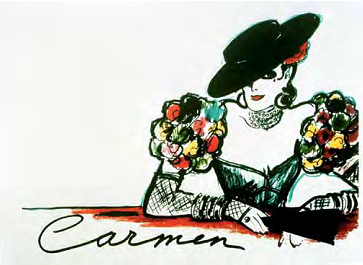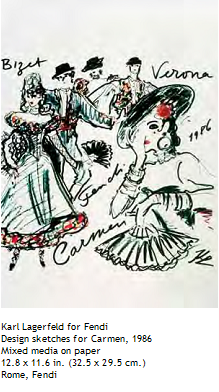

Editing Sample
FENDI TEXT PANEL
ORIGINAL
Adele Casagrande founded her leather and fur workshop in 1918. After marrying Edoardo Fendi in 1925 they established the Fendi name and grew creatively as the Fendi family expanded into new areas of fashion. Together with Karl Lagerfeld as Creative Director, Fendi moved beyond the traditional ideas of fur and leather, experimenting with form, texture, and color to create high fashion and classic couture. They embraced opera with a passion. As seen in the costumes for Carmen and La Traviata, designer Karl Lagerfeld was not afraid to incorporate the Fendi heritage, with the imaginative use of fur, fabric and their innate sense of style and luxury.
Fendi’s most elaborate engagement with the opera remains the sixty-three costumes created for Bizet’s Carmen in 1986. The costumes were a striking chromatic interpretation that was essential and modern: jeans with fur inserts in bursts of color. These designs were a triumph. Karl Lagerfeld and the Fendi’s presence in opera continue to dominate with 28 productions between 1980 and 2007.
EDITS
[[The text appearing in double brackets stands in for comments that would normally be balloons in the margins.]]Adele Casagrande founded her leather and fur workshop in 1918. Renaming the firm Fendi [[I made these changes because it was a misplaced modifier: THEY, as subject, cannot marry Edoardo; only she can marry Edoardo]] after marrying Edoardo Fendi in 1925, they established the Fendi name and she grew creatively as the Fendi family expanded into new areas of fashion. Together with Karl Lagerfeld as Creative Director, Fendi moved beyond the traditional ideas of fur and leather, experimenting with form, texture, and color to create high fashion and classic couture.
They embraced opera with a passion. As seen in [[I made this change because otherwise it's a dangling modifier (my favorite error!), putting Karl Lagerfeld literally IN the costumes.]] In designing the costumes for Carmen and La Traviata, designer Karl Lagerfeld was not afraid to [[Sorry; I had to rework “was not afraid to” since the exact phrase also appears in the Marras panel]] boldly incorporated the Fendi heritage with the imaginative use of fur, fabric, and their [[What does “their” refer to: fur & fabric, or the Fendis?]] innate sense of style and luxury. Fendi’s most elaborate engagement with the opera remains the sixty-three costumes created for In Bizet’s Carmen in 1986 in particular, the sixty-three elaborate costumes were a striking chromatic reinterpretation that was essential and modern: jeans with fur inserts in bursts of color. These Both essential and modern, these designs were a triumph.
Karl Lagerfeld and the Fendis presence in have continued their devotion to the opera for nearly three decades, designing costumes for continue to dominate with 28 twenty-eight productions between 1980 and 2007. [[Are you okay with these changes? I felt the piece should end with greater flourish.]]
FINAL

Adele Casagrande founded her leather and fur workshop in 1918. Renaming the firm Fendi after marrying Edoardo Fendi in 1925, she grew creatively as the Fendi family expanded into new areas of fashion. Together with Karl Lagerfeld as Creative Director, Fendi moved beyond the traditional ideas of fur and leather, experimenting with form, texture, and color to create high fashion and classic couture.
They embraced opera with a passion. In designing the costumes for Carmen and La Traviata, Karl Lagerfeld boldly incorporated the Fendi heritage with imaginative use of fur, fabric, and their innate sense of style and luxury. In Bizet’s Carmen in particular, the sixty-three elaborate costumes were a striking chromatic reinterpretation: jeans with fur inserts in bursts of color. Both essential and modern, these designs were a triumph.
Karl Lagerfeld and Fendi have continued their devotion to the opera for nearly three decades, designing costumes for twenty-eight productions between 1980 and 2007.
CREDIT
The edited version appeared as a text panel in the fashion exhibit Teatro alla Moda: Theater in Fashion at the Wallis Annenberg Center for the Performing Arts, 14 October 2011-18 March 2012, Beverly Hills, California.
I also edited the full-color catalogue: Teatro alla Moda: Theater in Fashion, hardcover, 182 pages, 2011.
Back to Editing Samples